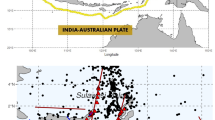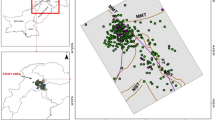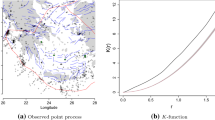Abstract
This paper explores the applicability of Inhomogeneous Log-Gaussian Cox point process to a complex spatial mechanism generating the tightly clustered locations of an earthquake aftershocks. The data constitutes the deadly 2023-Türkiye earthquake of magnitude 7.8 and its aftershocks of magnitudes as large as 7.5. Locations of active tectonic faults and the plate boundaries marked within the study area provide useful covariate information for explaining the aftershocks distribution pattern in 2-D spatial domain. The fitted Inhomogeneous Log-Gaussian Cox Point Process (LGCP) model is able to successfully account for this information. Intensity function of the model serves as a suitable choice to describe the intricate spatial mechanism underlying the earthquakes pattern generation. The available covariates information improves the performance of the fitted LGCP model in describing spatial variation of the density of earthquakes in terms of the distinct spatial features of the seismic region.











Similar content being viewed by others
Data availability
The data used in this manuscript are available on request.
Code availability
Not applicable.
References
Ambraseys NN, Jackson JA (1998) Faulting associated with historical and recent earthquakes in the Eastern Mediterranean region. Geophys J Int 133:390–406
Anwar S, Stein A, van Genderen JL (2012) Implementation of the marked Strauss point process model to the epicenters of earthquake aftershocks. In: Shi W, Goodchild MF, Lees B et al (eds) Advances in Geo-spatial Information Science, ISPRS Book Series, vol 42. CRC Press, Boca Raton, pp 125–140
Anwar S, Yaseen M, Mahmood SA (2022) Higher order Gibbs point process modeling of Kashmir earthquakes. Model Earth Syst Environ 9(1):1–13
Baddeley AJ (2005) Analysing spatial point patterns in ‘R’. J R Stat Soc 67:617–666
Baddeley AJ (2010) Modelling strategies. In: Gelfand AE, Diggle PJ, Fuentes M et al (eds) Handbook of spatial statistics. CRC Press, Boca Raton, pp 371–402
Baddeley A (2023) Personal communication. Email correspondence on September 25, 2023
Baddeley A, Silverman BW (1984) A cautionary example on the use of second-order methods for analyzing point patterns. Biometrics 40:1089–1093
Baddeley AJ, van Lieshout MNM (1995) Area-interaction point processes. Ann Inst Stat Math 47:601–619
Baddeley AJ, Turner R (2005) spatstat: an R package for analyzing spatial point patterns. J Stat Soft 12(6):1–42
Baddeley AJ, Turner R (2006) Modelling spatial point patterns in R. Lecture notes in Statistics. Springer, London, pp 23–74
Baddeley A, Gregory P, Mateu J et al (2006) Case studies in spatial point process modeling. Lecture notes in Statistics. Springer, London
Baddeley A, Rubak E, Turner R (2016) Spatial point patterns: methodology and applications with R. CRC Press, New York
Baddeley A, Davies TM, Hazelton ML et al (2022) Fundamental problems in fitting spatial cluster process models. Spat Stat 52:100709
Berman M, Diggle P (1989) Estimating weighted integrals of the second-order intensity of a spatial point process. J R Stat Soc 51:81–92
Besag J (1977) Contribution to the discussion on Dr Ripley’s paper. J R Stat Soc B 39:193–195
Choiruddin A, Trisnisa AF, Iriawan N (2021) Quantifying the effect of geological factors on distribution of earthquake occurrences by inhomogeneous Cox processes. Pure Appl Geophys 178:1579–1592
Cox DR (1955) Some statistical methods connected with series of events. J R Stat Soc Ser B (Methodol) 17:129–164
Cox DR, Isham V (1980) Point processes. In: Monographs on applied probability and statistics, vol 12. CRC Press, Boca Raton
Cressie NAC (1993) Statistics for spatial data. In: Handbook of spatial statistics, 2nd edn. Wiley-Interscience, London
Daley DJ, vere Jones D (2002) An introduction to the theory of point Processes, vol 1. Springer, London
D’Angelo N, Siino M, D’Alessandro A et al (2022) Local spatial log-Gaussian Cox processes for seismic data. Adv Stat Anal 106:633–671
D’Angelo N, Adelfio G, Mateu J (2023) Locally weighted minimum contrast estimation for spatio-temporal log-Gaussian Cox processes. Comput Stat Data Anal 180:107679
David D (2019) Introduction to the theory of Gibbs point processes. In: Shi W, Goodchild MF, Lees B et al (eds) Stochastic geometry, vol 42. Springer, London, pp 181–239
Diggle PJ (2003) Statistical analysis of spatial and spatio-temporal point patterns, vol 1. A Hodder Arnold Publication, London
Diggle PJ (2013) Statistical analysis of spatial point patterns, vol 128. Chapman and Hall, New York
Diggle PJ, Gomez-Rubio V, Brown PE et al (2007) Second-order analysis of inhomogeneous point processes using case-control data. Biometircs 63:550–557
Dvořák J (2011) On moment estimation method for spatial Cox processes. In: WDS’11 Proceedings of Contributed Papers, Part I. MATFYZPRESS, Charles University, Faculty of Mathematics and Physics, Prague, Czech Republic, pp 31–36
Fisher RA (1915) Frequency distribution of the values of the correlation coefficient in samples from an indefinitely large population. Biometrika 10:507–521
Foxall R, Baddeley A (2002) Nonparametric measures of association between a spatial point process and a random set, with geological applications. Appl Stat 51(2):165–182
Geyer CJ (1999) Likelihood inference for spatial point processes. In: Barndorff-Nielsen OE, Kendall WS, van Lieshout MNM (eds) Stochastic Geometry: Likelihood and Computation, Monographs on Statistics and Applied Probability, vol 80. Chapman and Hall/CRC, Boca Raton, pp 79–140
Grabarnik P, Särkkä A (2001) Interacting neighbour point processes: some models for clustering. J Stat Comput Simul 68(2):103–125
Harte DS (2014) An ETAS model with varying productivity rates. Geophys J Int 198:270–284
Högmander H, Särkkä A (1999) Multitype spatial point patterns with hierarchical interactions. Biometrics 55(4):1051–1058
Illian J, Penttinen A, Stoyan H et al (2008) Statistical analysis and modelling of spatial point patterns, vol 1. John Wiley & Sons, Chichester
Isham V (1984) Multitype Markov point processes: some approximations. Proc R Soc A Math Phys Eng Sci 391(1800):39–53
Jalilian A, Safari A, Sohrabi H (2020) Modeling spatial patterns and species associations in a Hyrcanian forest using a multivariate log-Gaussian Cox process. J Stat Model Theory Appl 1(2):59–76
McKenzie D (1972) Active tectonics of the Mediterranean region. Geophys J R Astr Soc 30(2):109–185
Møller J (2005) Properties of spatial Cox process models. J Stat Res Iran 2(1):2–18
Molnar P, Chen WP (1982) Seismicity and mountain building. In: Mountain building processes. Academic Press, New York, pp 41–57
Møller J, Waagepetersen RP (2007) Modern statistics for spatial point processes. Scand J Stat 34(4):643–684
Møller J, Syversveen AR, Waagepetersen RP (1998) Log Gaussian Cox Processes. Scand J Stat 25(3):451–482
Naji DM, Akin MK, Cabalar AF (2021) Evaluation of seismic site classification for Kahramanmaras City, Turkey. Environ Earth Sci 80(3):97
Ogata Y (1998) Space-time point-process models for earthquake occurrences. Ann Inst Stat Math 50(2):379–402
Ogata Y (2011) Significant improvements of the space-time ETAS model for forecasting of accurate baseline seismicity. Earth Planets Space 63:217–229
Ogata Y (2017) Statistics of earthquake activity: models and methods for earthquake predictability studies. Annu Rev Earth Planet Sci 45:497–527
Ogata Y, Zhuang J (2006) Space-time ETAS models and an improved extension. Tectonophysics 413(1–2):13–23
R Core Team (2023) R: a language and environment for statistical computing. R Foundation for Statistical Computing, Vienna. https://www.R-project.org/
Ripley BD (1988) Statistical inference for spatial processes. Cambridge University Press, University of Oxford, Oxford
Shearer P (2012) Space-time clustering of seismicity in California and the distance dependence of earthquake triggering. J Geophys Res Solid Earth 117(B10)
Siino M, Adelfio G, Mateu J et al (2017) Spatial pattern analysis using hybrid models: an application to the Hellenic seismicity. Stoch Environ Res Risk Assess 31:1633–1648
USGS (2023) Website. https://earthquake.usgs.gov/
van Lieshout MNM (2010) Spatial point process theory. In: Gelfand AE, Giggle PJ, Guttorp P et al (eds) Handbook of spatial statistics, vol 1. CRC Press, Boca Raton, pp 263–282
van Lieshout MNM (2011) A \(j\)-function for inhomogeneous point processes. Stat Neerl 65:183–201
van Lieshout MNM (2019) Theory of spatial statistics: a concise introduction, vol 36. CRC Press, Boca Raton
van Lieshout MNM, Baddeley AJ (1996) A non-parametric measure of spatial interaction in point patterns. Stat Neerl 50(3):344–361
vere Jones D (2009) Some models and procedures for space-time point processes. Environ Ecol Stat 16:173–195
Zilio LD, Ampuero JP (2023) Earthquake doublet in Turkey and Syria. Commun Earth Environ 4(1):71
Funding
This study was not funded by any grant.
Author information
Authors and Affiliations
Contributions
All authors contributed to the study conception and design. Statistical analysis of the data was performed by Dr. Salma Anwar. The second coauthor Dr. Muhammad Yaseen and third coauthor Dr. Muhammad Yaseen contributed in data collection and data processing. The fourth coauthor Dr. Yasir Latif contributed in literature review and graphics preparation. The first draft of the manuscript was written by Dr. Salma Anwar and all authors commented on previous versions of the manuscript. All authors read and approved the final manuscript.
Corresponding author
Ethics declarations
Conflict of interest
The authors declare that they have no competing interests.
Ethics approval
This article does not contain any studies with participants performed by any of the authors.
Consent to participate
This article does not contain any studies with participants performed by any of the authors
Consent for publication
Not applicable.
Rights and permissions
Springer Nature or its licensor (e.g. a society or other partner) holds exclusive rights to this article under a publishing agreement with the author(s) or other rightsholder(s); author self-archiving of the accepted manuscript version of this article is solely governed by the terms of such publishing agreement and applicable law.
About this article
Cite this article
Anwar, S., Yaseen, M., Yaseen, M. et al. Modeling spatial distribution of earthquake epicenters using inhomogeneous Log-Gaussian Cox point process. Model. Earth Syst. Environ. 10, 2917–2933 (2024). https://doi.org/10.1007/s40808-023-01940-x
Received:
Accepted:
Published:
Issue Date:
DOI: https://doi.org/10.1007/s40808-023-01940-x




